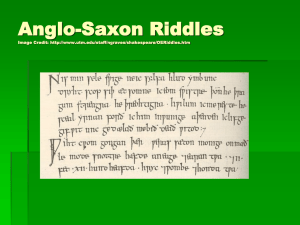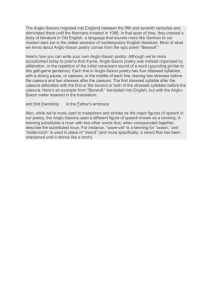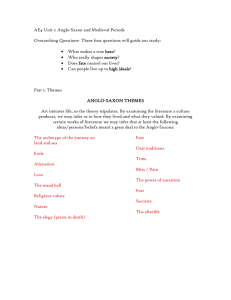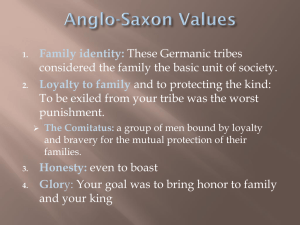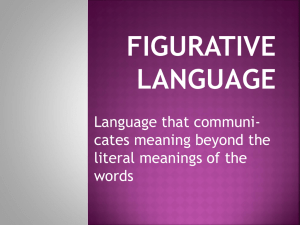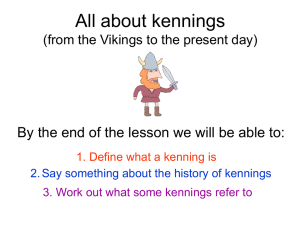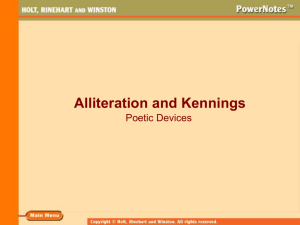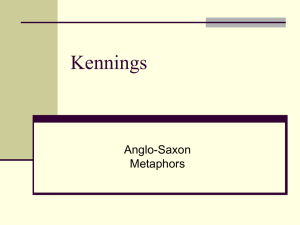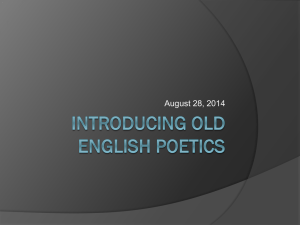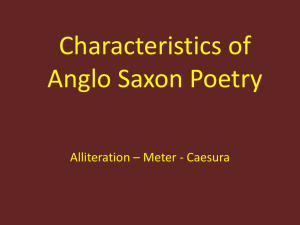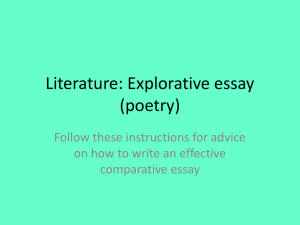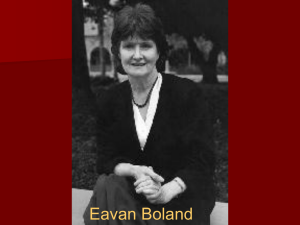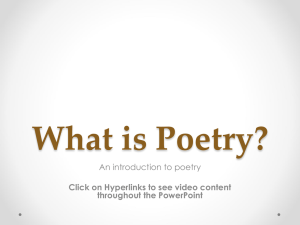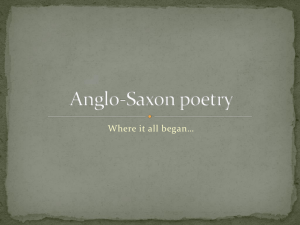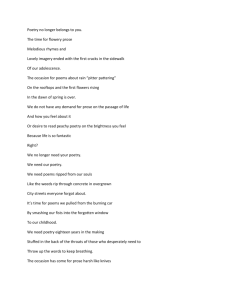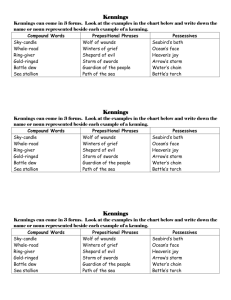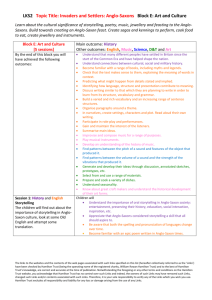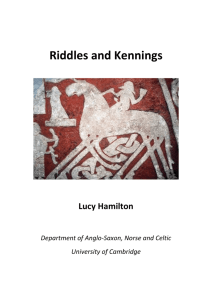Typical-Aspects-of-Anglo-Saxon-Literature
advertisement
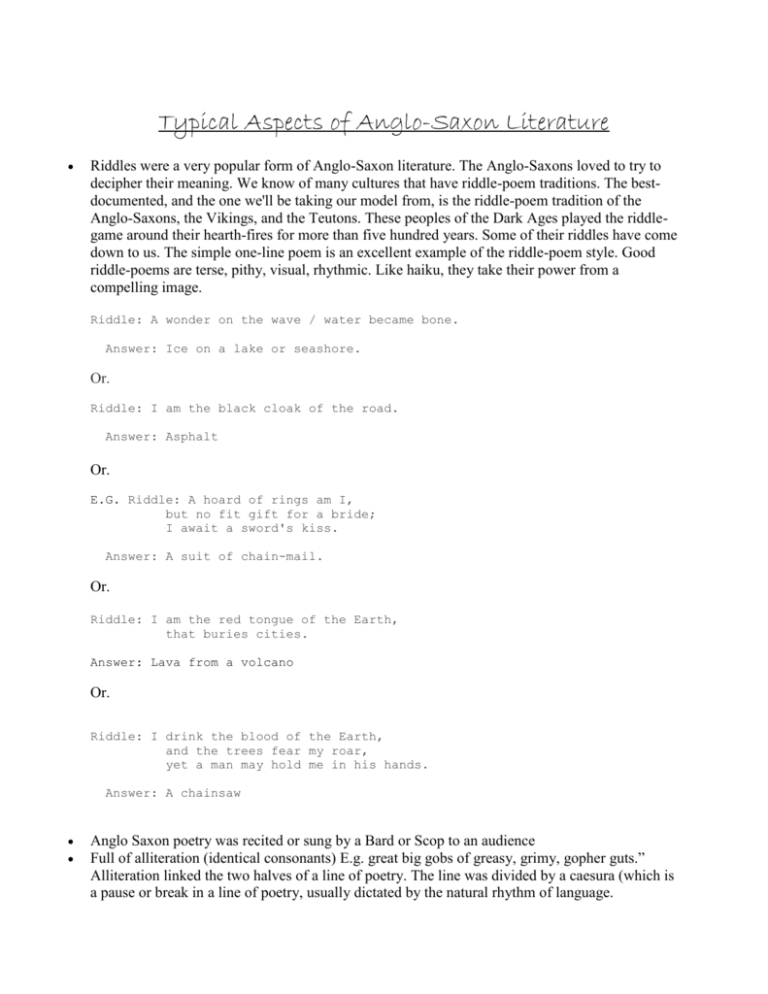
Typical Aspects of Anglo-Saxon Literature Riddles were a very popular form of Anglo-Saxon literature. The Anglo-Saxons loved to try to decipher their meaning. We know of many cultures that have riddle-poem traditions. The bestdocumented, and the one we'll be taking our model from, is the riddle-poem tradition of the Anglo-Saxons, the Vikings, and the Teutons. These peoples of the Dark Ages played the riddlegame around their hearth-fires for more than five hundred years. Some of their riddles have come down to us. The simple one-line poem is an excellent example of the riddle-poem style. Good riddle-poems are terse, pithy, visual, rhythmic. Like haiku, they take their power from a compelling image. Riddle: A wonder on the wave / water became bone. Answer: Ice on a lake or seashore. Or. Riddle: I am the black cloak of the road. Answer: Asphalt Or. E.G. Riddle: A hoard of rings am I, but no fit gift for a bride; I await a sword's kiss. Answer: A suit of chain-mail. Or. Riddle: I am the red tongue of the Earth, that buries cities. Answer: Lava from a volcano Or. Riddle: I drink the blood of the Earth, and the trees fear my roar, yet a man may hold me in his hands. Answer: A chainsaw Anglo Saxon poetry was recited or sung by a Bard or Scop to an audience Full of alliteration (identical consonants) E.g. great big gobs of greasy, grimy, gopher guts.” Alliteration linked the two halves of a line of poetry. The line was divided by a caesura (which is a pause or break in a line of poetry, usually dictated by the natural rhythm of language. E.g. (from the 4th line of “Beowulf” Alliteration of the/sc/ sounds: further alliteration. “Oft Scyld Scefing scaePena Preatum” Here you can see stresses in the first half and stresses in the second part; the caesura separates the two. Kennings – held great value in poems – they are metaphors, miniature hyphenated riddles that the Anglo Saxons enjoyed. E.g. Word for sea is ‘whale road’ Sword – ‘hammer leaving’ and ‘battle light’ Woman – ‘peace weaver,’ ‘dwelling ornament’ Ship – ‘wave skimmer’ Repetition important –to stress emphasis often resulting in the use of synonyms Themes: heroism, loyalty, loneliness, sorrow, love, joy, appreciation for beauty. There are few humorous or trivial incidents portrayed (perhaps it was because the Monks were the ones who kept the information). Several Types of Poems: Lyric poems (explores emotions and sensations; it is brief and creates a single impression for the reader; name come from the Lyre because the sound patterns echo music, and Elegiac poems (formal poetic lament for the dead), E.g.; “The Wife’s Lament,” “The Husband’s Message,” “The Wanderer,” “The Seafarer,” and “The Rune.” Heroic poems (poems written about a hero extolling his virtues.) Germanic hero is strong, fearless, bold and stoic in his acceptance of fate. E.g. “Beowulf.” Historical Battle Poems (as title suggests) – “Battle of Maldon” Popular Poetry – riddles, charms, chants and rituals to ward off real or imagined dangers Religious Poetry – “Caveman’s Hymn,” “Elene,” “The Phoenix.” Prose: consisted of histories written by Kings and churchman. Lies of Saints, and Soliloquy of the Occupations were typical of the prose of that time. There were a number of qualities found in Anglo-Saxon poetry: Heroic behavior is praised Almost no romantic love An overall effect to formalize and elevate language, often through the use of literary devices. For instance: Synecdoche: a part used to express the whole, or vice versa. Ex: 50 sails=50 boats Metonymy: the naming of a person, institution, or human characteristic by some object or attribute with which is closely associated. Ex: Crown, Majesty= Ruler Kenning: a compound of two words in place of another. Ex: whale-road=sea, loaf-giver = king, lifehouse = body Litotes: ironic understatement; an emphatic expression through an ironic understatement. Ex: “he's no beauty." Themes: A very common theme is "ubi sunt" "where have they gone?" This was a rough, hard time of life. The average age for men was 45, for women, 36. It was not totally unusual to lose one's entire family to war, famine or some other calamity. Practicing ** Listening Activity: After reviewing Riddles earlier, listen to the following Riddles, and try to decipher what they are describing or referring to. *** Making your own Riddle in small groups. Please use the examples given to model your own. Kennings What common object do all of the following kennings describe? What essential quality of the object does each kenning focus on? Arrow aimer Dust terror Antique printer Tickle tool Fowl Fashion One of the literary devices popular in the Anglo-Saxon Old English poetry tradition is the Kenning. Read the definition below and ready yourself to take a stab at this delightfully metaphorical way of speaking, writing, and thinking. Kenning – is a circumlocution; a literary device in which a noun is renamed in a creative way using a compound word or union of two separate words to combine ideas If you call "school" a "scholar's home" -- then you have created a kenning. If you tell your friends that your parents are the "car loaners" -- then you have created a kenning. The folks at Coca-Cola might agree that a cold Coke is "humanity's beverage." To what would each of these Anglo-Saxon kennings refer? 1. 2. 3. 4. 5. Sky candle Swan of blood Sea-stallion Almighty’s enemy Gold-giver 6. Whale road 7. Battle-dew 8. Bone house 9. Mail-shirt 10. Spear Trees Part One: Consider carefully how you could creatively rename each of the following through the use of the kenning technique. 1. A teacher 2. A bus driver 3. Firemen 4. Television 5. Pizza 6. Police 7. Pop tarts 8. Music 9. Love 10. Computer Part Two: (Practice) In small groups write 5 complete sentences which each incorporate the use of kennings to achieve a creative description.
